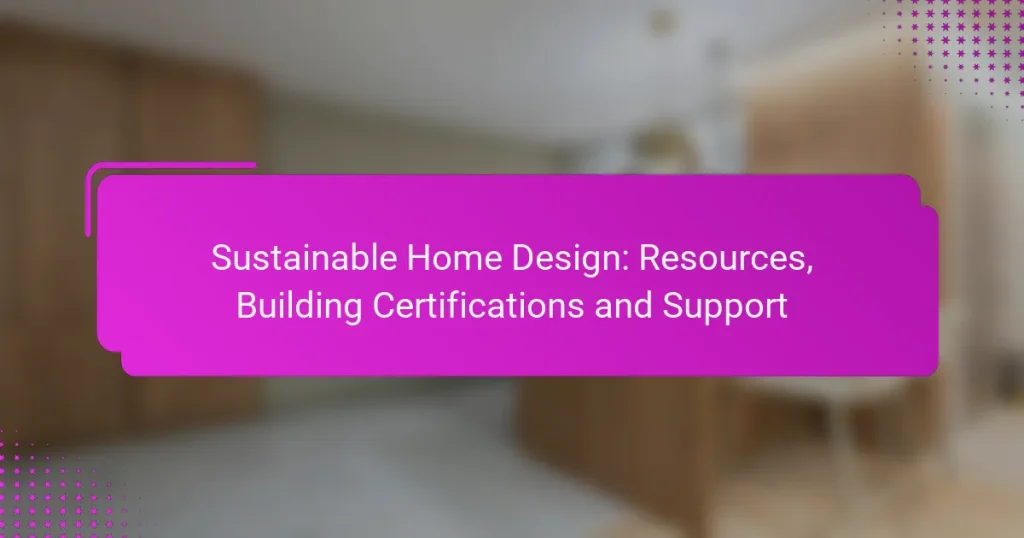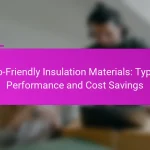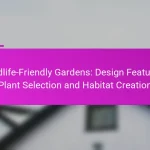Sustainable home design prioritizes energy efficiency and environmental stewardship, employing strategies such as passive solar design and rainwater harvesting. Achieving certifications like LEED requires adherence to specific sustainability criteria, often necessitating professional guidance. Numerous resources, including government incentives and non-profit organizations, are available to support eco-friendly building practices and provide innovative solutions for homeowners.

What are the best sustainable home design solutions in California?
The best sustainable home design solutions in California focus on maximizing energy efficiency and minimizing environmental impact. Key strategies include passive solar design, green roofs, energy-efficient windows, rainwater harvesting systems, and insulated concrete forms.
Passive solar design
Passive solar design utilizes the sun’s energy for heating and cooling without mechanical systems. By strategically placing windows and using thermal mass materials, homes can maintain comfortable temperatures year-round. In California, consider orienting your home to maximize sunlight exposure, especially in winter months.
Incorporating overhangs and shading devices can prevent overheating during the summer. This design approach not only reduces energy costs but also enhances indoor comfort.
Green roofs
Green roofs involve planting vegetation on rooftops to provide insulation, reduce heat absorption, and manage stormwater. In California, they can significantly lower urban heat island effects and improve air quality. When designing a green roof, choose drought-resistant plants to conserve water.
Consider the structural capacity of your home to support the added weight of soil and plants. Regular maintenance is essential to ensure plant health and roof integrity.
Energy-efficient windows
Energy-efficient windows minimize heat loss and gain, contributing to overall home energy efficiency. Look for windows with a low U-factor and high solar heat gain coefficient (SHGC) to optimize performance in California’s climate. Double or triple glazing can further enhance insulation.
Proper installation is crucial; ensure windows are sealed correctly to prevent air leaks. Consider window films or shades to reduce glare and improve comfort without sacrificing natural light.
Rainwater harvesting systems
Rainwater harvesting systems collect and store rainwater for non-potable uses, such as irrigation and toilet flushing. In California, where water conservation is vital, these systems can significantly reduce reliance on municipal water supplies. Ensure your system complies with local regulations regarding water quality and usage.
Installing a filtration system can improve water quality for irrigation. Regular maintenance, including cleaning gutters and checking for leaks, is necessary to keep the system functioning effectively.
Insulated concrete forms
Insulated concrete forms (ICFs) are energy-efficient building materials that provide superior insulation and structural strength. They consist of expanded polystyrene foam blocks filled with concrete, which helps maintain consistent indoor temperatures. In California, ICFs can enhance energy efficiency and reduce heating and cooling costs.
While ICFs may have a higher upfront cost compared to traditional framing, the long-term savings on energy bills can offset the initial investment. Additionally, they are resistant to pests and fire, making them a durable choice for sustainable homes.
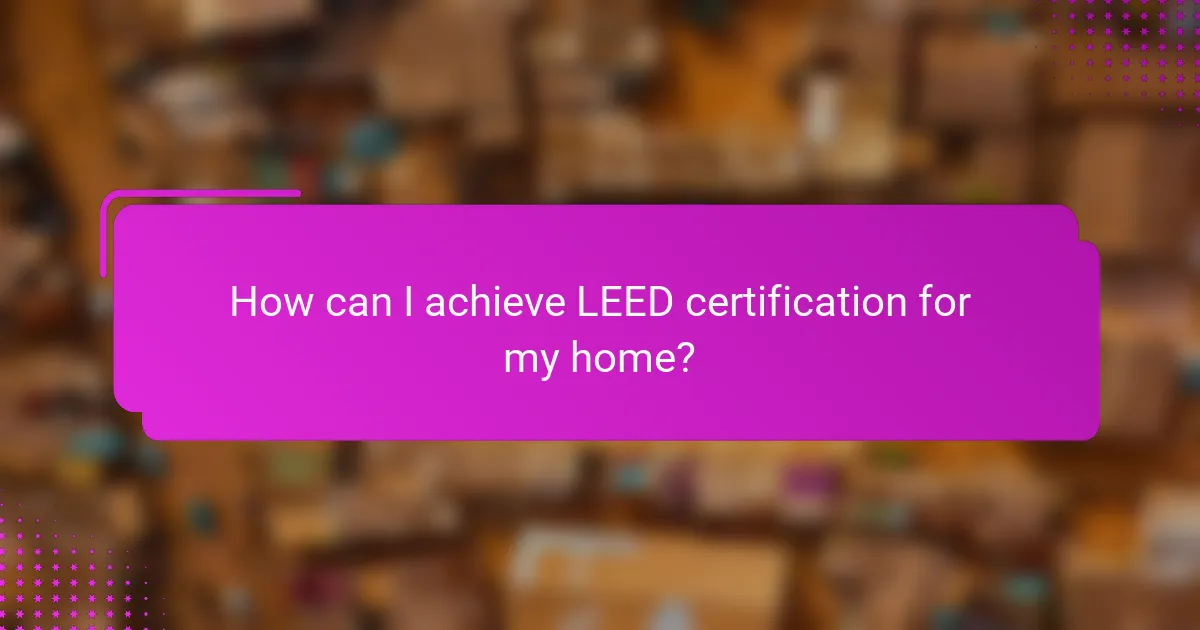
How can I achieve LEED certification for my home?
To achieve LEED certification for your home, you must meet specific sustainability criteria across various categories. This process involves understanding LEED standards, completing a checklist, and often hiring a professional with LEED accreditation to guide you through the requirements.
Understand LEED categories
LEED certification is divided into several categories, including Sustainable Sites, Water Efficiency, Energy and Atmosphere, Materials and Resources, Indoor Environmental Quality, and Innovation. Each category has its own set of prerequisites and credits that contribute to your overall score.
Familiarizing yourself with these categories helps you identify which areas your home can improve upon. For instance, enhancing energy efficiency or using sustainable materials can significantly boost your LEED score.
Complete a LEED checklist
A LEED checklist outlines the specific requirements and credits needed for certification. You can find templates online that guide you through the process, detailing what actions you need to take in each category.
As you complete the checklist, keep track of your progress and ensure you have documentation for each credit claimed. This documentation is crucial for the certification review process.
Hire a LEED-accredited professional
Engaging a LEED-accredited professional can streamline your path to certification. These experts are trained to navigate the complexities of the LEED process and can provide valuable insights on best practices and potential pitfalls.
When selecting a professional, look for someone with experience in residential projects and a solid understanding of local building codes and regulations. Their expertise can save you time and help ensure your home meets all necessary standards for certification.
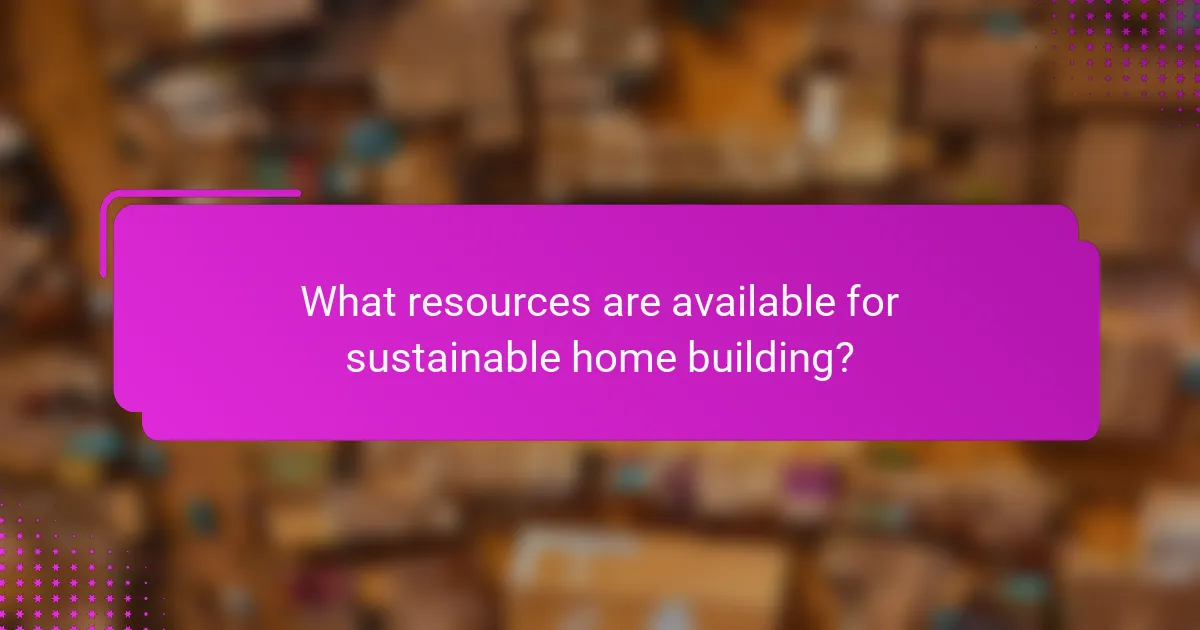
What resources are available for sustainable home building?
Various resources can assist in sustainable home building, including government incentives, non-profit organizations, and online design tools. These resources provide financial support, guidance, and innovative solutions to promote eco-friendly construction practices.
Local government incentives
Many local governments offer incentives to encourage sustainable home building, such as tax credits, grants, or low-interest loans. These programs can significantly reduce upfront costs, making green building more accessible for homeowners.
To take advantage of these incentives, check with your local municipality or state government for available programs. Requirements may vary, so ensure your project meets specific criteria to qualify for financial assistance.
Non-profit organizations
Non-profit organizations play a crucial role in promoting sustainable building practices by providing resources, education, and sometimes funding. Groups like Habitat for Humanity and the U.S. Green Building Council offer workshops, materials, and guidance on eco-friendly construction techniques.
Engaging with these organizations can help you stay informed about best practices and connect with a community of like-minded individuals. Many non-profits also offer certifications that can enhance the credibility of your sustainable home project.
Online design tools
Online design tools are invaluable for planning sustainable homes, allowing users to visualize energy-efficient layouts and materials. Platforms like SketchUp and Home Designer Suite offer features specifically tailored for green building, helping you optimize space and resource use.
When using these tools, consider integrating features like passive solar design and energy-efficient appliances to maximize sustainability. Many of these applications also provide cost estimates, helping you stay within budget while achieving your eco-friendly goals.
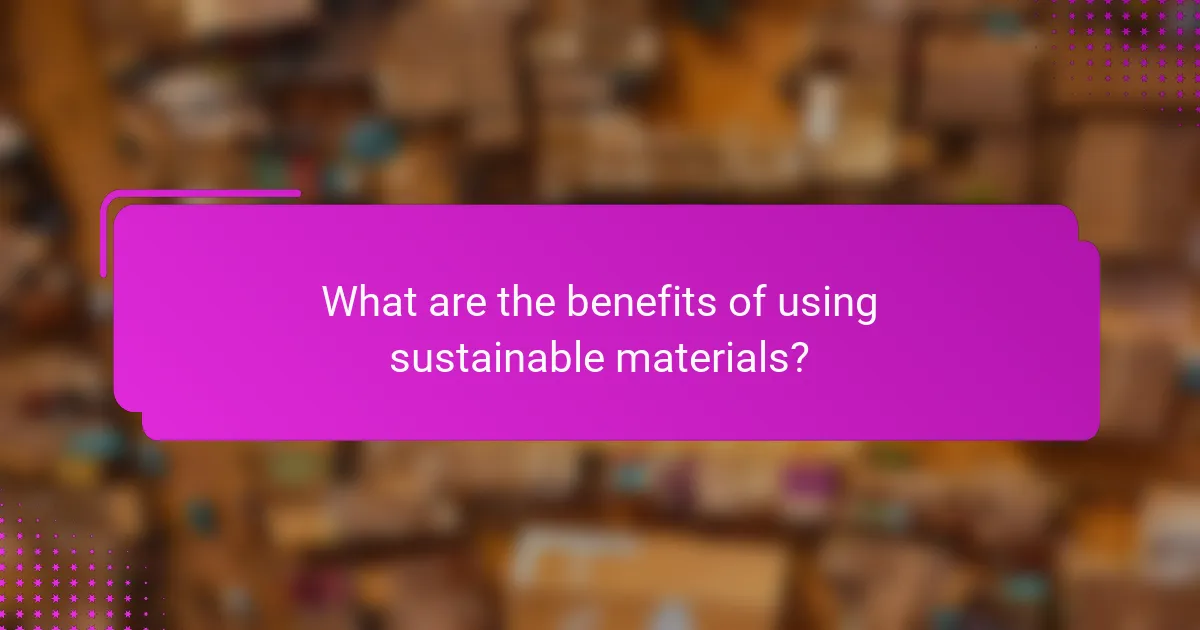
What are the benefits of using sustainable materials?
Using sustainable materials in home design offers numerous advantages, including reduced environmental impact, improved indoor air quality, and long-term cost savings. These materials are sourced responsibly and often have a lower carbon footprint compared to conventional options.
Reduced environmental impact
Sustainable materials are typically made from renewable resources, which helps minimize the depletion of natural resources. For instance, bamboo and reclaimed wood are excellent choices as they require less energy to produce and can be sourced without harming ecosystems.
Additionally, many sustainable materials are designed to be recyclable or biodegradable, reducing waste in landfills. Choosing materials with certifications, such as FSC (Forest Stewardship Council), can further ensure that your selections contribute to environmental preservation.
Improved indoor air quality
Many sustainable materials are free from harmful chemicals and volatile organic compounds (VOCs) that can negatively affect indoor air quality. For example, natural paints and finishes, as well as low-VOC adhesives, help create a healthier living environment.
Using materials like cork, wool, or natural fibers can also enhance air quality by regulating humidity and reducing allergens. This is particularly beneficial for individuals with respiratory issues or sensitivities.
Long-term cost savings
Investing in sustainable materials can lead to significant long-term cost savings. While the initial investment may be higher, these materials often have greater durability and lower maintenance costs, resulting in savings over time.
Moreover, energy-efficient materials can reduce utility bills by improving insulation and reducing energy consumption. For example, using high-performance windows and insulation can lead to savings of 20-30% on heating and cooling costs.

How do I select a sustainable architect in New York?
Selecting a sustainable architect in New York involves evaluating their expertise in eco-friendly design, certifications, and past work. Focus on professionals who prioritize energy efficiency, sustainable materials, and innovative design solutions that align with your project goals.
Check for certifications
When choosing a sustainable architect, verify their certifications related to green building practices. Look for credentials such as LEED (Leadership in Energy and Environmental Design) or other recognized sustainability programs. These certifications indicate a commitment to environmentally responsible design.
In New York, architects may also be familiar with local regulations and incentives for sustainable building, which can enhance your project’s viability. Ensure that the architect’s certifications are current and relevant to the specific sustainability goals you have in mind.
Review past projects
Investigating an architect’s previous projects can provide insight into their design style and effectiveness in sustainable practices. Request a portfolio showcasing completed works that emphasize energy efficiency, sustainable materials, and innovative solutions. Pay attention to projects that have received accolades or recognition for their sustainability efforts.
Consider visiting some of these projects if possible, as firsthand experience can help you assess the quality and functionality of their designs. Look for diversity in their portfolio to ensure they can adapt to different styles and requirements.
Ask for client testimonials
Client testimonials can offer valuable perspectives on an architect’s reliability, communication, and ability to deliver sustainable designs. Reach out to former clients to inquire about their experiences and satisfaction with the architect’s work. Positive feedback regarding the architect’s approach to sustainability can be particularly telling.
Additionally, consider checking online reviews and ratings on platforms dedicated to architecture and design. This can provide a broader understanding of the architect’s reputation in the New York area, helping you make a more informed decision.

What are the key features of a net-zero energy home?
A net-zero energy home produces as much energy as it consumes over the course of a year. This is achieved through a combination of energy-efficient design, renewable energy sources, and smart energy management.
Energy Efficiency
Energy efficiency is crucial for a net-zero energy home. This includes high-performance insulation, energy-efficient windows, and advanced HVAC systems that minimize energy consumption. Implementing these features can reduce energy needs by 30-50% compared to standard homes.
Consider using Energy Star-rated appliances and LED lighting to further enhance energy efficiency. These choices not only lower energy use but also contribute to long-term cost savings.
Renewable Energy Sources
To achieve net-zero status, homes typically incorporate renewable energy systems, such as solar panels or wind turbines. Solar photovoltaic (PV) systems are the most common, converting sunlight into electricity. Depending on location, a well-placed solar array can offset a significant portion of energy consumption.
Homeowners should evaluate local incentives for renewable energy installations, which can help offset initial costs. In many regions, tax credits or rebates are available, making solar installations more affordable.
Energy Management Systems
Effective energy management systems are essential for monitoring and optimizing energy use in a net-zero energy home. Smart thermostats, energy monitoring apps, and automated lighting systems can help homeowners track their energy consumption and adjust usage accordingly.
Integrating these technologies allows for real-time adjustments, ensuring that energy production and consumption are balanced. Homeowners should consider systems that are compatible with their renewable energy sources for maximum efficiency.
Building Materials
Using sustainable building materials is another key feature of net-zero energy homes. Materials such as reclaimed wood, recycled steel, and low-VOC paints contribute to a healthier indoor environment and reduce the carbon footprint of construction.
When selecting materials, prioritize those with high durability and low environmental impact. This not only supports sustainability but also enhances the longevity and performance of the home.
Site Orientation and Design
The orientation and design of a net-zero energy home can significantly influence its energy performance. Homes should be positioned to maximize natural light and passive solar heating while minimizing heat loss. This often involves strategic placement of windows and overhangs.
Consulting with an architect experienced in sustainable design can help optimize site orientation and ensure that the home takes full advantage of its surroundings, leading to reduced energy needs.
